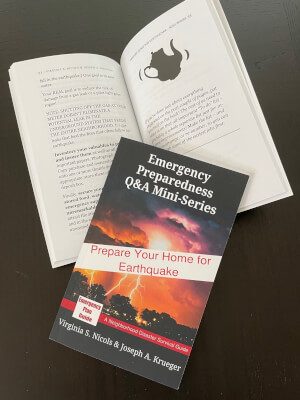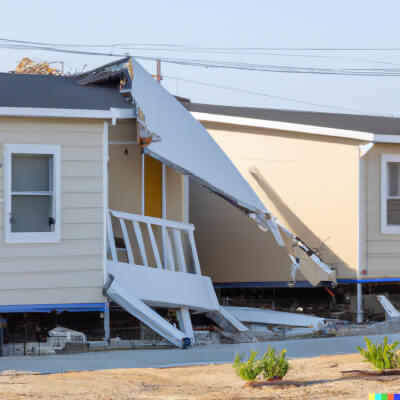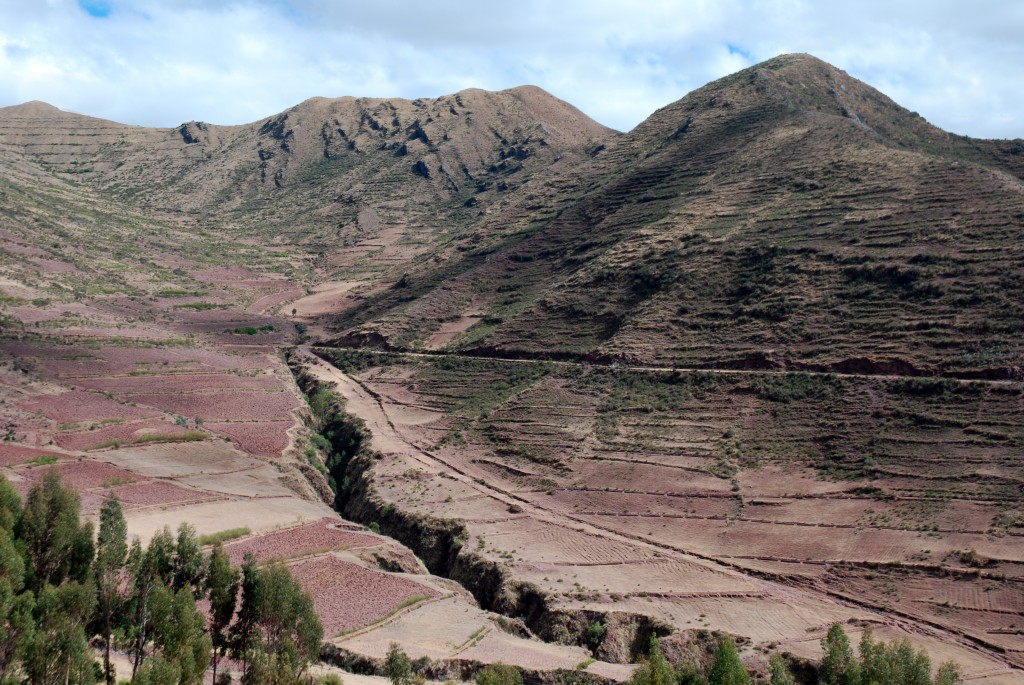Wilderness survival is still — and always — a hot topic. But according to the most recent census, only 14 percent of Americans live outside a metropolitan area — 86 percent of us look to a metro area for jobs, activities and amenities. So when it comes to disaster preparedness, we need urban survival skills!

A safe room anywhere?
As far as I can tell, urban or suburban survival translates directly into being prepared to shelter in place.
Let’s take another look at some of the requirements for being able to effectively shelter in place.
First choice for a great place to shelter — a safe room
Even in an urban setting, you may be able to construct a traditional safe room inside your house. If you are in full construction or upgrade mode, you would build your room to code and include safety and comfort features. You might even go to the effort to make the room unobtrusive or even invisible, with a hidden door.
If you live in an apartment, though, choices are different. For you, the best idea would probably be to turn an existing room or an interior walk-in closet (big enough for everyone) into a strengthened room that could better withstand a storm or even an incursion by bad people.
In either case, designing and creating a special room would take money — probably anywhere from $1,000 (VERY low end) to as much as $10,000.Whatever your budget, and whatever the home you’re starting with, here are 5 major areas to focus on.
1. Door and walls: reinforced steel door frame, exterior-style reinforced door that opens INWARD, and heavy-duty deadbolt locks. Get the best you can afford that won’t totally overwhelm the space or stick out like a sore thumb. Whatever you do, be sure to secure hinges with 3-inch screws and use 3 inch screws on the strike plate of your lock, too. Here’s an example of a deadbolt lock highly rated by Consumer Reports. The lock is expensive — over $100 — but as Consumer Reports points out, it’s probably not more than your insurance deductible.


Paint the door and trim to match the rest of the house. You may even want to consider a hidden door; take a look at this model, built by the well-known Murphy bed company:


As for walls, they can be reinforced by pouring concrete into the spaces between the studs, or adding a layer of kevlar or steel sheeting and then covering it with drywall.
2. Windows are difficult to reinforce, so plan a safe room with NO windows.
3. Water and sanitation: It would be great if you had a bathroom built in. If not, store water and get a camping potty, realizing you’ll have to empty it at some point. I’m a big believer in 5-gallon buckets for a variety of uses. Here’s one that serves as a portable toilet. (If you already have a bucket, you can probably get an attachable toilet seat for about $10.)


4. Ventilation: If your room is too tight, you won’t be able to breathe. Figure out appropriate ventilation (not requiring fans — remember, the power will be off).
5. Food and other emergency supplies: Your room is a good place to store your emergency supplies — food, emergency radio, lights, first aid, warm clothing, tools, etc. Don’t forget your prescription medicines.
Interested in more about safe rooms? FEMA has produced some very detailed plans, suitable for a professional builder. (Start your search here.) And Wikihow’s article about building a safe room, here, is a good overview.
In the aftermath of the storm
Assume the storm is over, you and your family are safe, but your home or building has been partly damaged. What might you need in order to make sure it’s habitable for a while, since you have no place else to go?
1, Basic hand tools and construction supplies
If the power is out, power tools are out, too. You’ll need battery operated tools to start — and you’ll soon be down to hand tools. You probably have some of the following tools at home now, or can get them locally. Just be sure to have them BEFORE the disaster threatens. Your local hardware stores will sell out immediately.
And as you shop, consider quality. Poor quality tools are dangerous and ineffective.
This is a simple starter list. The more skill or experience you have, the more you’ll want to add.
With a good hammer, saw and/or hacksaw, and pry bar you can remove debris. I have used tools like these many times, and as a non-professional I’ve found that the right weight and size is really important. Too heavy, you just can’t wield the tool for very long. Too light, it won’t do the job. Below, you’ll see some examples along with my comments.
- Hammer 16 oz one piece flat for ripping. We’ve all used hammers, but the standard home hammer has a rounded head (so it doesn’t damage the wood) and a rounded claw (for pulling out nails). If you build a lot, your home hammer probably has a wooden or a rubberized handle to lessen the vibration. If you’re not really into tools, you may have a short handled hammer or tack hammer that you use to hang pictures. But for emergency use you need something different — something TOUGH and HEAVY enough to rip apart debris. This one looks great, and isn’t expensive. (Click on the image to get current prices.)


- These days we don’t use hand saws much, since everybody has a power saw. However, in an emergency your power tools will be useless. You’ll need a traditional, all purpose saw. This Stanley version is only 18 inches long, not as long as a carpenter’s serious wood-cutting saw, but I think it would be just right for in-close work.


- Use leverage instead of your own muscle power! Again, the right length and weight of a prybar is important. We have several prybars in our shed, from 12 in. long up to 30 in. (and one giant one for rescue). I find that a 24 inch bar is carryable, packable, and still long enough so you can apply the pressure you need.


- You will definitely want a tarp and tape to keep out the weather. This tarp is big enough but not too big, and it’s not too thick, either. (The heaviest quality might work fine for a semi-permanent install, but in our experience is just too difficult to work with in a temporary emergency situation.)
 As for duct tape, I just assume you already have some! (Again, click on the image below to see full details and price for this tarp, and to compare to others.)
As for duct tape, I just assume you already have some! (Again, click on the image below to see full details and price for this tarp, and to compare to others.)


Store these materials where you’ll be able to get to them when the storm is over.
2. Specialty tools for dealing with debris
Work gloves – get the right size! These gloves, for example, come in six different sizes; they have a wrist adjustment, leather palms for a good grip, etc. Actually, Joe and I have two pairs of gloves each in our Survival Kits, to start with.


3. Dealing with metal
Not everything can be disassembled by force. In an urban setting you may need to open metal cabinets, remove fallen ceiling ductwork, get into utility closets, etc.. To do this, you’ll need to unscrew, unlock or cut wire or metal. (A pair of safety goggles is a good idea, here.)
A very good multi-tool can be easily stored and can serve a number of these construction purposes. (Avoid a multi-tool with hammer. It won’t be heavy enough to do the debris management we’re talking about.)
Some of the very best Swiss army type tools have the usual blades and saws, including metal saws, and also include different size screw drivers plus a ratchet with multiple bits. There are different models, and prices vary from around $120 to over $200, so it’s a good idea to shop.
Start your shopping by looking at the Victorinox Spirit Plus model, shown below. This is one of the very few products on Amazon that gets awarded five full stars by users. I’d look carefully at this one. It’s pretty pricey (around $150 as I write this), but superior in every way. Click on the image to get current pricing.


As a comparison, the Leatherman Wingman Multi-tool is one we recommend for carrying in your 3-day survival kit.


It has basic blades and screwdriver, and costs $35 – $40. (Click image to get exact pricing at Amazon.) Both the Leatherman and the Victorinox weigh about the same amount – 5-7 oz. – so that’s not a deciding factor.
As always, pick tools appropriate for the person using them.
Good tools leverage the strength of the user, but only when they are properly used. Be sure children know how to use any tools before including them in a child’s survival kit or handing them over for a child to do a job. (As I am sure you have found, some kids are really very capable — but they need training!)
OK, that’s it for now. In an upcoming Advisory we’ll be talking about staying warm in an urban setting. Stay tuned. . . and in the meanwhile, get those multi-tools!
Virginia
Your Emergency Plan Guide Team








































 Plus, just two days ago we emerged from a heightened earthquake alert resulting from a swarm of 140+ small quakes near the base of the San Andreas Fault. That’s the seismic fault that’s going to give birth to the long-overdue “Big One.”
Plus, just two days ago we emerged from a heightened earthquake alert resulting from a swarm of 140+ small quakes near the base of the San Andreas Fault. That’s the seismic fault that’s going to give birth to the long-overdue “Big One.”



